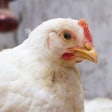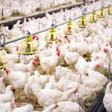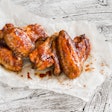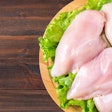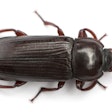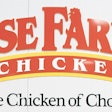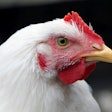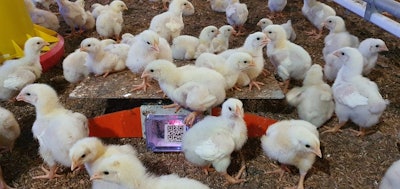
More accurate weights, and weight predictions, give farmers the information they need to make better decisions.
Weighing birds
Weight is one of the most important key performance indicators for the poultry industry. Bird weight is a key metric for assessing feed conversion ratio, as well as monitoring changes in bird health and welfare.
In addition, poultry weight predictions help with supply chain planning. With this information, poultry operations can better plan for and schedule their feed and processing needs.
Today, most broilers are weighed by steelyard or platform scale, which is time-consuming and labor-intensive. The catch and release process used is also stressful for the birds, negatively impacting welfare.
Weight forecasting also allows them to react early to red flags, such as illness, more quickly, preventing disease outbreaks and maintaining flock well-being by reducing periods of suboptimal growth patterns.
Three steps to a better weight estimate
One new poultry weight monitoring technology integrates machine learning and algorithms.
“We’ve tried to reimagine poultry weighing as much as possible for some sort of synergy within the poultry farm and the poultry farmer’s understanding and expectations,” Giovanni dos Reis Montefiori, founder of Beakbook, said.
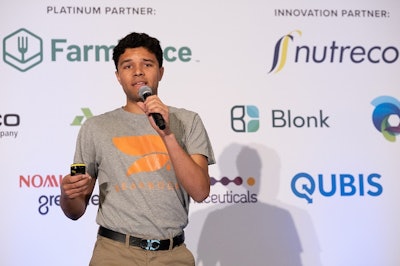
It relies upon a three-step process: data collection, data processing and data visualization. First, the farmer collects the weights of the birds in the house using the Beakbook scale or any commercially available scale.
The resulting data looks very messy, noisy and can be difficult to understand, so the next step is an algorithm that decodes the information to provide the daily mean and standard deviation bird weights in the house.
The third step is data visualization, which gives the farmers access to trending data via a web application.
The poultry weighing technology recently completed a successful trial in conjunction with pan-Asia industrial agricultural and processed food company Japfa. During the trial, it demonstrated 97% accuracy for mean weight over a nine-month period in the validation phase. It also predicted the mean weight of chickens seven days in advance with a prediction accuracy of more than 97%.
The pilot study lasted nine months and involved approximately 280,000 broilers. Japfa, which produces upwards of 600 million day-old chicks per year, and Beakbook are currently exploring future collaborations, including the possibility of adding 3D imaging to the poultry weighing technology to improve the accuracy of the results.
Computer vision made simple
In the future, 3D imaging which leverages a combination of computer vision and artificial intelligence (AI) could provide real-time flock weight insights with predictive modeling data.
The service Birdoo, built by Knex and backed by Cargill, uses a shoe-box sized camera, hung approximately four feet off the ground, to capture and estimate the weight of the birds in the house. Because the camera also features an AI-powered computer, the data captured is processed into a text file, a benefit for poultry facilities in rural areas with less-reliable internet.
“It is trained to estimate the weight of the birds and this information gets sent to the cloud,” Mahender Singh, founder of Knex, said.

One of the biggest benefits of using 3D imaging is that it doesn’t disrupt normal bird activity in the poultry house.
“It just stays there, and the chickens live underneath it,” Singh said. "They do what they do and it keeps taking these images and scoring individual bird weight."
The service can estimate broiler weights with greater than 95% accuracy and no labor is required to calibrate the device.
Farmers and other stakeholders view the predictions on a cloud-based platform that tracks poultry growth and weight and anticipates potential health, welfare and supply chain issues.
“Essentially the whole value chain comes into alignment if you know this data accurately,” Singh said. "It’s not just for the farmers. It’s not just to manage the farm better. With this data, what you can do up and down the whole value chain is fairly significant."
With IoT, weight predictions improve over time
Using a digital technology known as the Internet of Things (IoT) could result in more accurate, automated broiler weight predictions on the farm.
“The technology has a learning curve. With every month that passes, we see greater accuracy,” Silke Schantz, procurement manager at Exceldor, said at the 2022 Poultry Tech Summit.
IoT uses the data collected by sensors, software and other technologies to communicate with other networks. In this case, data collected at the poultry farm is fed into predictive models that use machine learning and algorithms.
In trials, the IoT solution had less than 50 gram error margin seven days before the planned catching date.
Currently, many poultry operations predict future bird weighs manually. However, this is a complex process requiring integration of a lot of data – from feed to management styles to weather.
The ability to automate this process has several benefits, including improved visibility when it comes to uniformity, size and total inventory of the birds. It also saves time for growers and staff because more accurate weight predictions help with live haul planning and can streamline and optimize operations throughout the entire poultry supply chain.
In addition, IoT is programmed to learn as it goes, so the results will improve over time.
“With this program, we are able to try and help our producers produce,” Shantz said. “It’s a tool to learn how to predict the weights.”
AI can help producers optimize poultry house conditions WATTAgNet.com/articles/46313






